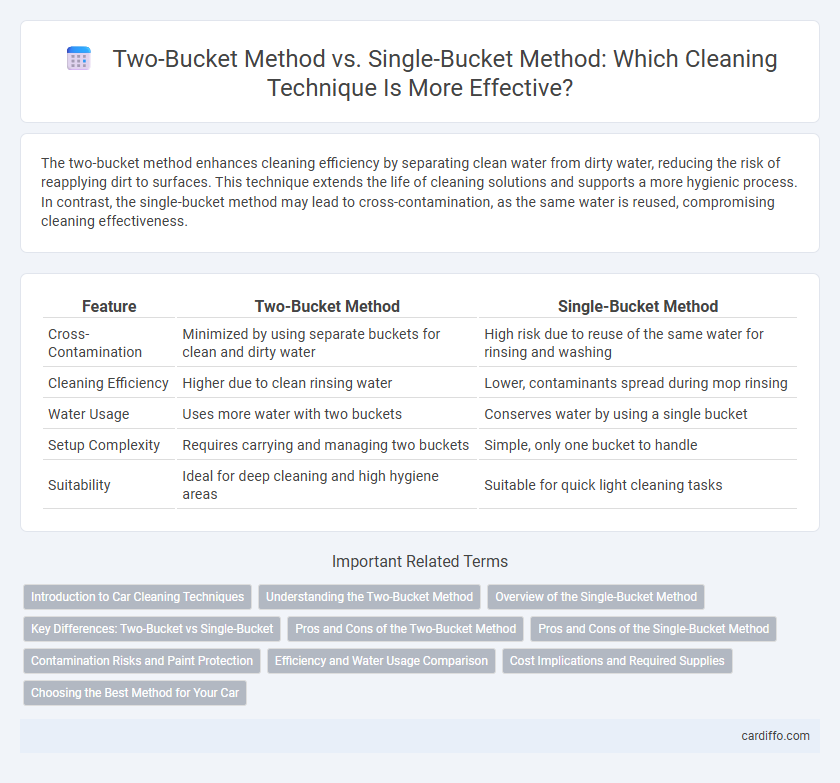The two-bucket method enhances cleaning efficiency by separating clean water from dirty water, reducing the risk of reapplying dirt to surfaces. This technique extends the life of cleaning solutions and supports a more hygienic process. In contrast, the single-bucket method may lead to cross-contamination, as the same water is reused, compromising cleaning effectiveness.
Table of Comparison
| Feature | Two-Bucket Method | Single-Bucket Method |
|---|---|---|
| Cross-Contamination | Minimized by using separate buckets for clean and dirty water | High risk due to reuse of the same water for rinsing and washing |
| Cleaning Efficiency | Higher due to clean rinsing water | Lower, contaminants spread during mop rinsing |
| Water Usage | Uses more water with two buckets | Conserves water by using a single bucket |
| Setup Complexity | Requires carrying and managing two buckets | Simple, only one bucket to handle |
| Suitability | Ideal for deep cleaning and high hygiene areas | Suitable for quick light cleaning tasks |
Introduction to Car Cleaning Techniques
The two-bucket method enhances car cleaning by separating rinse water from soapy water, reducing the risk of dirt and grit recontaminating the wash mitt and vehicle surface. In contrast, the single-bucket method uses one container for both washing and rinsing, which can transfer debris back onto the paint, increasing the chance of scratches. Utilizing microfiber wash mitts and proper drying techniques further improves the effectiveness and safety of either car cleaning method.
Understanding the Two-Bucket Method
The two-bucket method significantly reduces cross-contamination by separating clean water from dirty water while cleaning, enhancing hygiene and surface cleanliness. Using one bucket for soapy water and another for rinsing helps maintain cleaning efficiency and prevents redistributing dirt and germs. This method is especially vital in healthcare and food preparation environments where sanitation standards are critical.
Overview of the Single-Bucket Method
The single-bucket method uses one container for both cleaning solution and rinsing, simplifying setup and reducing equipment needs. It is less effective at preventing dirt transfer compared to the two-bucket method because the mop is rinsed and wrung in the same solution used for cleaning. This method is more suitable for light cleaning tasks or quick maintenance in low-traffic areas.
Key Differences: Two-Bucket vs Single-Bucket
The two-bucket method uses separate buckets for clean water and rinse water, reducing cross-contamination and improving cleaning efficiency. The single-bucket method combines clean and dirty water in one container, which can lead to dirt redepositing on surfaces. Choosing the two-bucket method enhances hygiene and extends the lifespan of cleaning tools.
Pros and Cons of the Two-Bucket Method
The Two-Bucket Method offers superior cleaning efficiency by using one bucket for clean water and another for rinsing, which reduces cross-contamination and prolongs the effectiveness of the cleaning solution. Its main drawback is the increased complexity and time required for setup and management compared to the Single-Bucket Method. This approach is particularly advantageous for deep cleaning tasks where thorough sanitation and preventing the spread of dirt and germs are critical.
Pros and Cons of the Single-Bucket Method
The Single-Bucket Method simplifies cleaning by using only one bucket for water and detergent, reducing preparation time and equipment needed, ideal for quick or light cleaning tasks. However, this method risks cross-contamination, as dirty water is not separated from clean water, potentially spreading dirt and bacteria back onto surfaces. Despite its convenience, the Single-Bucket Method may result in less effective cleaning and requires frequent water changes to maintain hygiene standards.
Contamination Risks and Paint Protection
The Two-Bucket Method significantly reduces contamination risks by using one bucket for rinsing and another for clean soap solution, preventing dirt and debris from re-entering the wash mitt. This separation protects paint surfaces from swirl marks and scratches caused by abrasive particles, ensuring a safer, gentler cleaning process. In contrast, the Single-Bucket Method increases contamination risk as dirt accumulates in one solution, heightening the chance of paint damage during washing.
Efficiency and Water Usage Comparison
The Two-Bucket Method significantly improves cleaning efficiency by reducing cross-contamination between dirty and clean water, resulting in more effective dirt removal with less effort. It also optimizes water usage by minimizing the need for frequent water changes, unlike the Single-Bucket Method, which quickly accumulates grime and requires more water for rinsing. This method not only conserves water but also enhances overall cleaning performance, making it a preferred choice in sustainable cleaning practices.
Cost Implications and Required Supplies
The Two-Bucket Method requires more supplies, including two separate buckets, a grit guard, and potentially more cleaning solutions, increasing initial costs but reducing the risk of contaminating wash water and damaging surfaces over time. The Single-Bucket Method uses fewer supplies, thus lowering upfront expenses, but may lead to higher long-term costs due to increased chances of scratching or contaminating surfaces from dirty water reuse. Investing in the Two-Bucket Method often results in better surface protection and durability, offsetting the initial higher supply costs.
Choosing the Best Method for Your Car
The two-bucket method minimizes paint contamination by separating soapy water from rinse water, ensuring a cleaner wash and reducing swirl marks on your car's surface. The single-bucket method is simpler but increases the risk of dirt particles being reapplied, potentially damaging paint over time. For optimal car care, especially on delicate or high-gloss finishes, the two-bucket method is the best choice to preserve the vehicle's appearance and longevity.
Two-Bucket Method vs Single-Bucket Method Infographic

 cardiffo.com
cardiffo.com